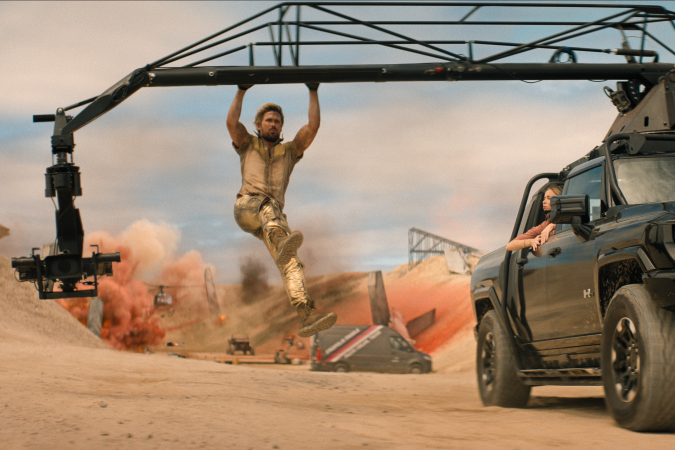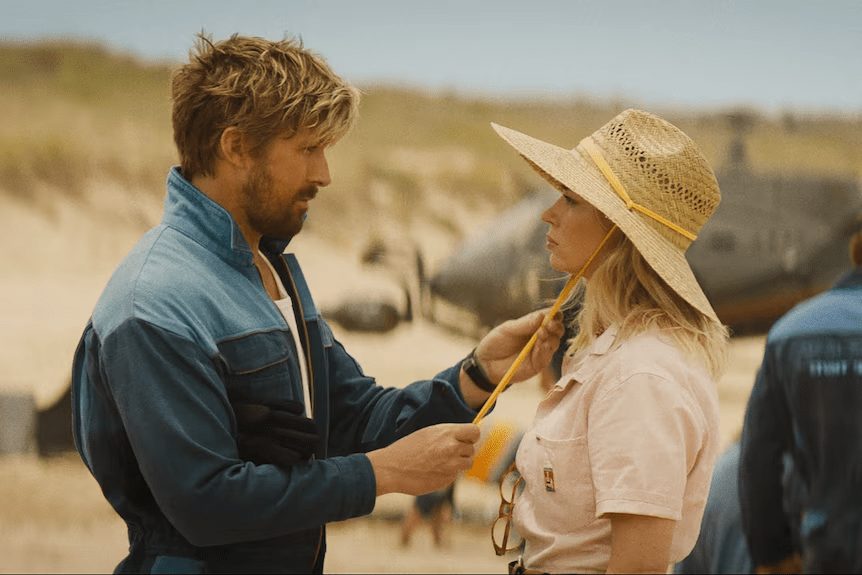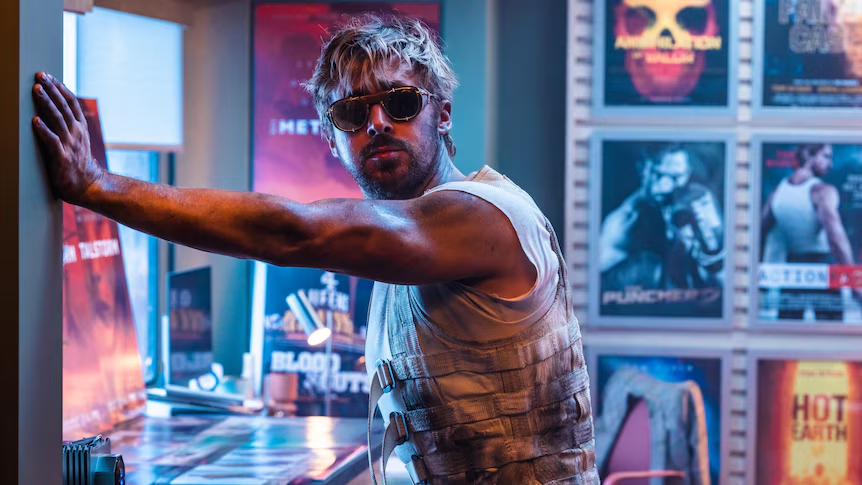The Fall Guy is a good film, not quite a great one. But it’s a great David Leitch film—his best since John Wick (2014).
A few years ago, the notion of a ‘David Leitch film,’ with all the implications that phrase carries, seemed farcical. After the first Wick, he became a gun for hire. Charlize Theron sought him out for her passion project, 2017’s Atomic Blonde. He was deployed similarly for the 2022 Brad Pitt vehicle Bullet Train. Between those films he made two vacuous, cynical franchise entries: 2018’s Deadpool 2 and 2019’s Hobbs & Shaw. His action remained robust, but it became increasingly mechanical. Compare this to his Wick co-director Chad Stahelski, who continued on with the franchise, bending it to his particular neon-soaked vision, elevating the scope, the stunts, and the box office returns with each entry. The narrative seemed clear, a Hollywood tale as old as time: one talent rises while another wanes. And Leitch was the loser in this equation.
At first glance, The Fall Guy looks like more of the same. Another middling action-comedy starring one of Hollywood’s biggest leading men in peak dude-bro mode. In reality, it is a madcap love letter to all the people that bring movies to life. From above-the-line talent, to extras, to craft services, and especially (especially!) stunt performers. It’s also a confirmation of something I’ve suspected for some time, that while Leitch has the skills to direct action, it would be a mischaracterisation to call him an ‘action director’ the way people do Stahelski. Rather, he is a director of actors. Or, more specifically, a director of Movie Stars—capital M, capital S. Someone with an innate understanding of, and ability to play with, their on-screen personas.

And what a star he has in Ryan Gosling. The actor shines as Colt Seavers, a movie stuntman who was the best in the business for a time, body-doubling for the biggest star in the world, Tom Ryder (Aaron Taylor-Johnson), before a stunt accident took him out of the game. He’s lured back in after a year and a half by studio producer Gail Meyer (Hannah Waddingham) to work on a sci-fi blockbuster being filmed in Sydney. The draw and the complication is the film’s director, Jody (Emily Blunt). On the one hand, Colt adores her, and she holds something of a flame for him from a previous on-set romance. On the other hand, Colt ghosted her following his accident, to his shame and her resentment.
It’s not long before we learn that Gail has other reasons for bringing Colt back into the fold. Tom Ryder has gone missing, and she needs Colt to find him before the studio catches wind and pulls the plug on the entire production. Why Colt? Because he’s a stuntman, and nobody will notice his absence. These stakes, however, are secondary. The film’s primary concerns are always interpersonal. Will Colt put his pride aside long enough to apologise? Will Jody be able to finish principle shooting before the production falls apart? Will they kiss and make up?

Gosling and Blunt are in a load-bearing position here; the film lives and dies on your investment in their relationship. Luckily both are at their most charismatic, and they have great chemistry to boot. Whenever they’re in a scene together, no matter how expository and functional, it crackles. You’d be happy watching them read a Chinese take-out menu.
Thank god, too, because the screenplay is a clunker. It’s penned by Drew Pearce, who was one of the co-writers on Hobbs & Shaw, and it has all the same shortcomings as its predecessor. The story beats are both predictable (you can see the ‘twist’ villain coming from a mile off) and repetitive (the plot is driven forward by incriminating recordings on three separate occasions, which is two too many if you ask me). In classic 21st century blockbuster fashion, the whole thing runs about half-an-hour too long. And the dialogue—oh, the dialogue. It’s too circular, too pithy, and overreliant on references to other, better films: The Fugitive, Rocky, The Last of the Mohicans, and (Jesus Christ, that’s) Jason Bourne.
Leitch manages to compensate for some of these shortcomings with his grasp of Movie Star personas, using them to make the characters—and therefore the character-centric story beats—feel more dimensional. Colt, for instance, is positioned at the intersection of Gosling’s two ‘types.’ On the surface he’s all First Man and Blade Runner 2049 stoicism, but this is a paper-thin façade. Underneath, he is one big emotional open wound: the suffering heart of La La Land’s Sebastian combined with the comedy of Barbie’s Ken. The film gets a lot of mileage out of this internal tension, although my favourite single moment would have to be Colt crying to Taylor Swift’s ‘All Too Well’ while thinking about his lost romance with Jody, only to hastily wipe away his tears when she knocks at his window.
Blunt, meanwhile, is leaning all the way into her uber-competent, ever-harried persona which she trademarked in 2006’s The Devil Wears Prada and has spent the rest of her career refining. That tight-lipped smirk, that tilted, slightly condescending look; they do a lot to elevate a character that is pretty flat on paper. Still, there’s only so much she can do. Jody is at the centre of the narrative’s stakes, but it’s not until the third act that she fully understands what’s going on and can lend a hand in shaping them. This leaves her frustratingly passive. For a large portion of the runtime her sole purpose is to embody the film’s values. She is making her directorial debut, a sci-fi romantic epic called Metalstorm. It’s being filmed on location with minimal CGI and maximum practical effects—which, as it happens, is exactly how The Fall Guy was filmed.

The result of this practical approach is tactile and weighty, making for some of Leitch’s best action to date. He’s always struggled to make set pieces feel seamless (one need only look at the stairwell fight from Atomic Blonde, which was inexplicably and unsuccessfully filmed to look like a single take). That issue is sidestepped here; several sequences are situated within the context of on-set stunt work, thus removing the need for seamless visual trickery. The thrill is not in the illusion, but in understanding the illusion’s construction. There’s a clear point of view, one that reveres the craft of filmmaking—the technicians behind that thing we call ‘movie magic,’ and the perfect-teethed stars that inject emotional reality. It’s worth noting, however, that these two halves of the film never quite tessellate. They come close with Colt, who is costumed in a way that evokes Gosling’s character in Drive, but it’s never clear what point they’re trying to make with this allusion.
This is the first time a film has felt personal to Leitch, like an expression of his worldview. He has spent years celebrating the human element in filmmaking, loudly rallying for a stunt-work Oscar. The Fall Guy, for all its unevenness, is his most persuasive argument yet. That it happens to be a light, poppy blockbuster, delivering a shotgun blast of adrenaline that’ll leave you giddy and grinning? Well, all the better for those of us who like a good time.
The Fall Guy is now showing across Australia.
**********
Joshua Sorensen is a writer, bookseller, and committee member for #LoveOzYA based in Naarm. Movies starring Holly Hunter are to him what lamps are to David Byrne.


